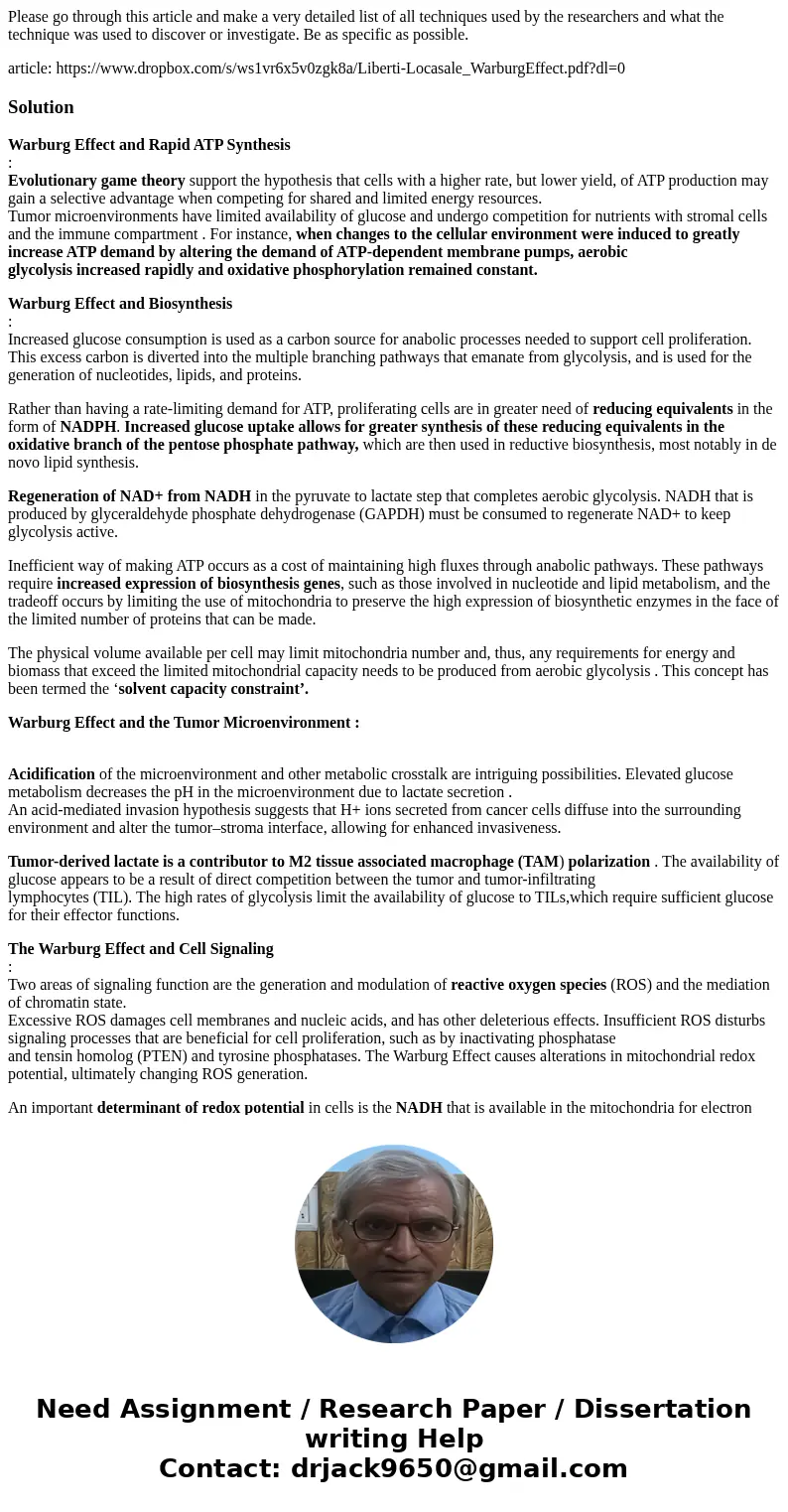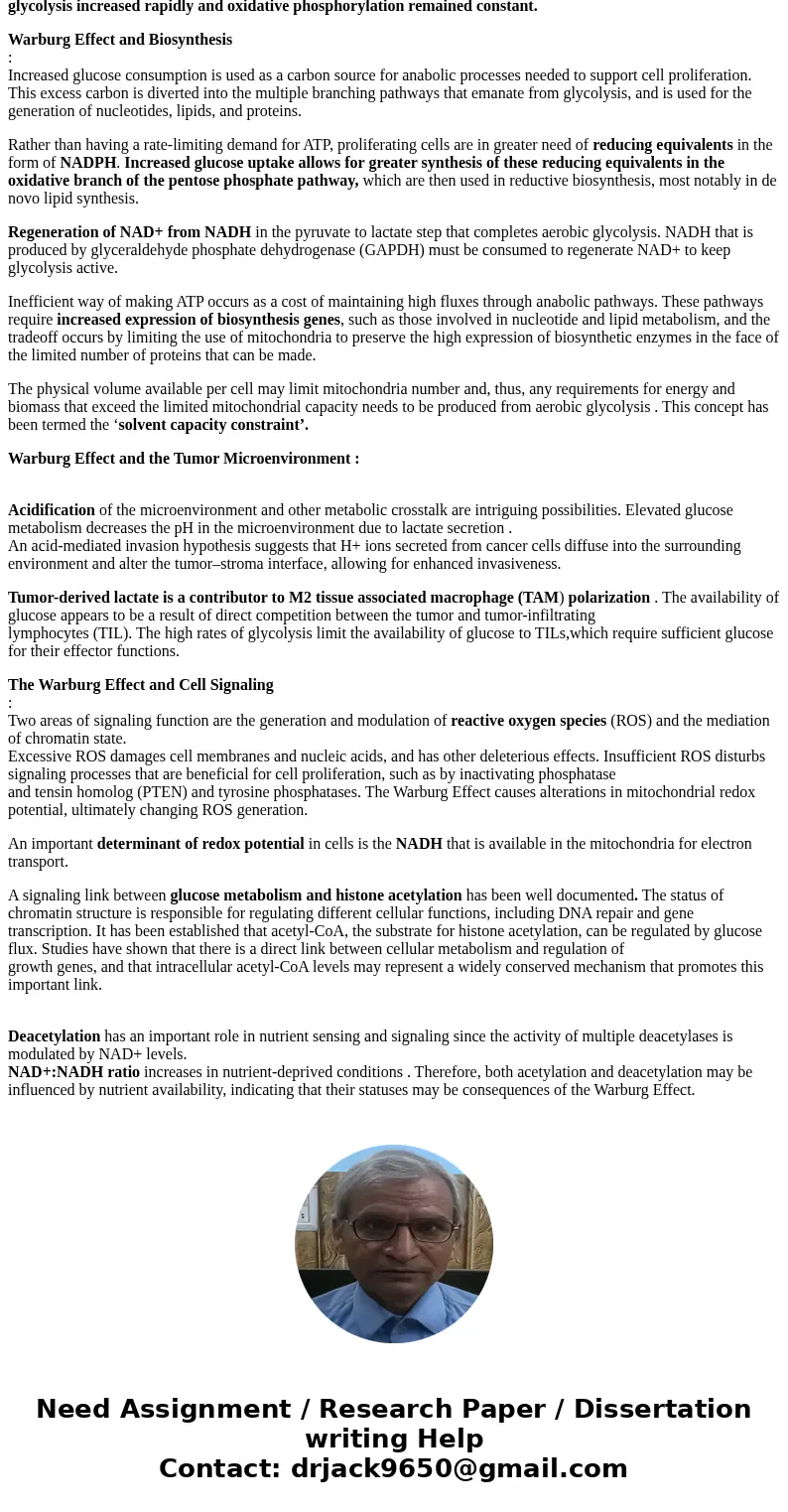Please go through this article and make a very detailed list
Please go through this article and make a very detailed list of all techniques used by the researchers and what the technique was used to discover or investigate. Be as specific as possible.
article: https://www.dropbox.com/s/ws1vr6x5v0zgk8a/Liberti-Locasale_WarburgEffect.pdf?dl=0
Solution
Warburg Effect and Rapid ATP Synthesis
:
Evolutionary game theory support the hypothesis that cells with a higher rate, but lower yield, of ATP production may gain a selective advantage when competing for shared and limited energy resources.
Tumor microenvironments have limited availability of glucose and undergo competition for nutrients with stromal cells and the immune compartment . For instance, when changes to the cellular environment were induced to greatly increase ATP demand by altering the demand of ATP-dependent membrane pumps, aerobic
glycolysis increased rapidly and oxidative phosphorylation remained constant.
Warburg Effect and Biosynthesis
:
Increased glucose consumption is used as a carbon source for anabolic processes needed to support cell proliferation. This excess carbon is diverted into the multiple branching pathways that emanate from glycolysis, and is used for the generation of nucleotides, lipids, and proteins.
Rather than having a rate-limiting demand for ATP, proliferating cells are in greater need of reducing equivalents in the form of NADPH. Increased glucose uptake allows for greater synthesis of these reducing equivalents in the oxidative branch of the pentose phosphate pathway, which are then used in reductive biosynthesis, most notably in de novo lipid synthesis.
Regeneration of NAD+ from NADH in the pyruvate to lactate step that completes aerobic glycolysis. NADH that is produced by glyceraldehyde phosphate dehydrogenase (GAPDH) must be consumed to regenerate NAD+ to keep glycolysis active.
Inefficient way of making ATP occurs as a cost of maintaining high fluxes through anabolic pathways. These pathways require increased expression of biosynthesis genes, such as those involved in nucleotide and lipid metabolism, and the tradeoff occurs by limiting the use of mitochondria to preserve the high expression of biosynthetic enzymes in the face of the limited number of proteins that can be made.
The physical volume available per cell may limit mitochondria number and, thus, any requirements for energy and biomass that exceed the limited mitochondrial capacity needs to be produced from aerobic glycolysis . This concept has been termed the ‘solvent capacity constraint’.
Warburg Effect and the Tumor Microenvironment :
Acidification of the microenvironment and other metabolic crosstalk are intriguing possibilities. Elevated glucose metabolism decreases the pH in the microenvironment due to lactate secretion .
An acid-mediated invasion hypothesis suggests that H+ ions secreted from cancer cells diffuse into the surrounding environment and alter the tumor–stroma interface, allowing for enhanced invasiveness.
Tumor-derived lactate is a contributor to M2 tissue associated macrophage (TAM) polarization . The availability of glucose appears to be a result of direct competition between the tumor and tumor-infiltrating
lymphocytes (TIL). The high rates of glycolysis limit the availability of glucose to TILs,which require sufficient glucose for their effector functions.
The Warburg Effect and Cell Signaling
:
Two areas of signaling function are the generation and modulation of reactive oxygen species (ROS) and the mediation of chromatin state.
Excessive ROS damages cell membranes and nucleic acids, and has other deleterious effects. Insufficient ROS disturbs signaling processes that are beneficial for cell proliferation, such as by inactivating phosphatase
and tensin homolog (PTEN) and tyrosine phosphatases. The Warburg Effect causes alterations in mitochondrial redox potential, ultimately changing ROS generation.
An important determinant of redox potential in cells is the NADH that is available in the mitochondria for electron transport.
A signaling link between glucose metabolism and histone acetylation has been well documented. The status of chromatin structure is responsible for regulating different cellular functions, including DNA repair and gene transcription. It has been established that acetyl-CoA, the substrate for histone acetylation, can be regulated by glucose flux. Studies have shown that there is a direct link between cellular metabolism and regulation of
growth genes, and that intracellular acetyl-CoA levels may represent a widely conserved mechanism that promotes this important link.
Deacetylation has an important role in nutrient sensing and signaling since the activity of multiple deacetylases is modulated by NAD+ levels.
NAD+:NADH ratio increases in nutrient-deprived conditions . Therefore, both acetylation and deacetylation may be influenced by nutrient availability, indicating that their statuses may be consequences of the Warburg Effect.


 Homework Sourse
Homework Sourse